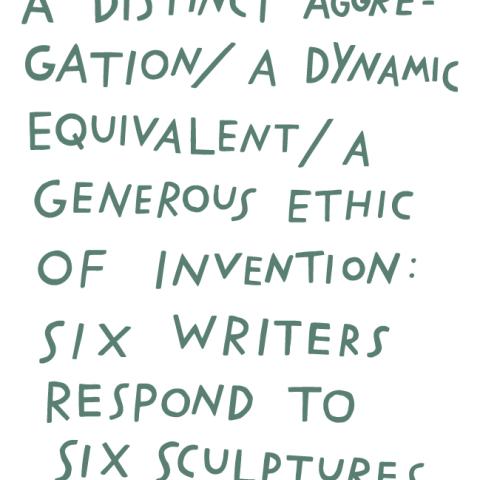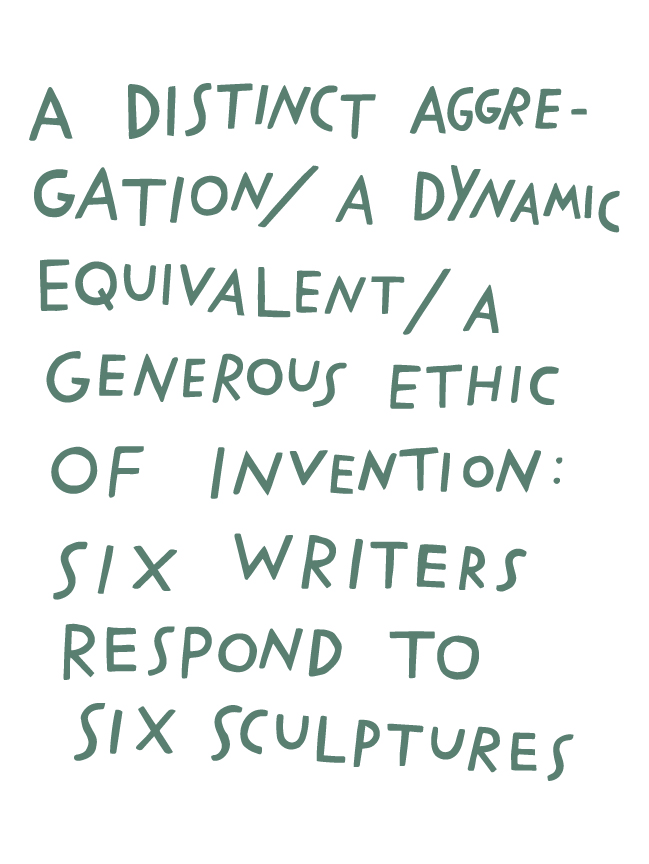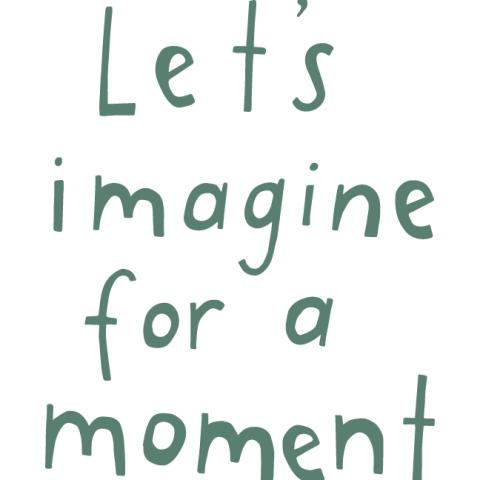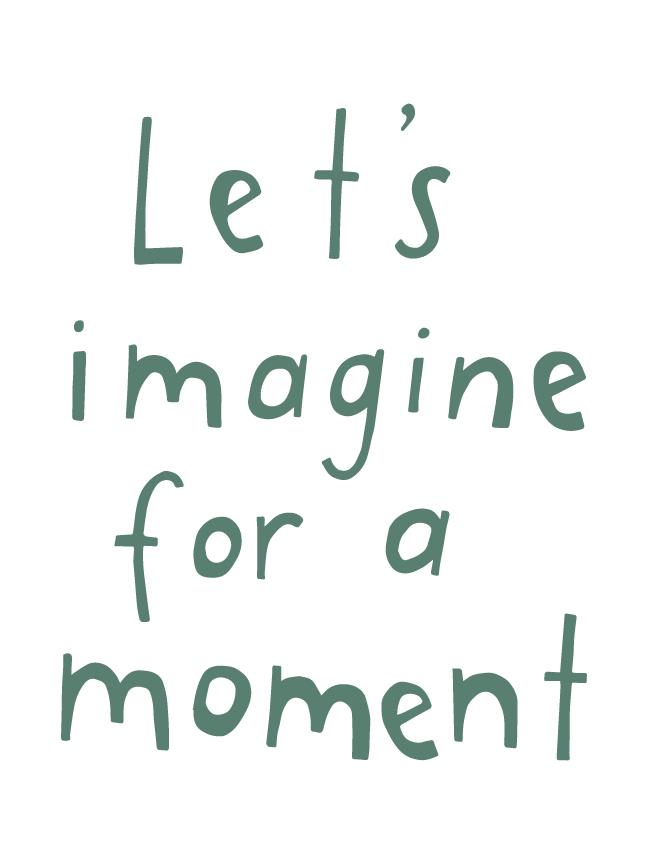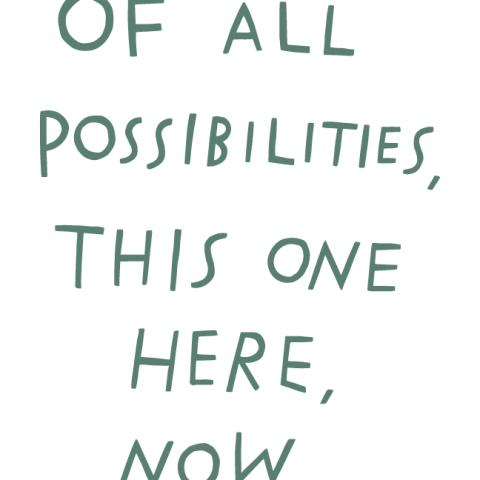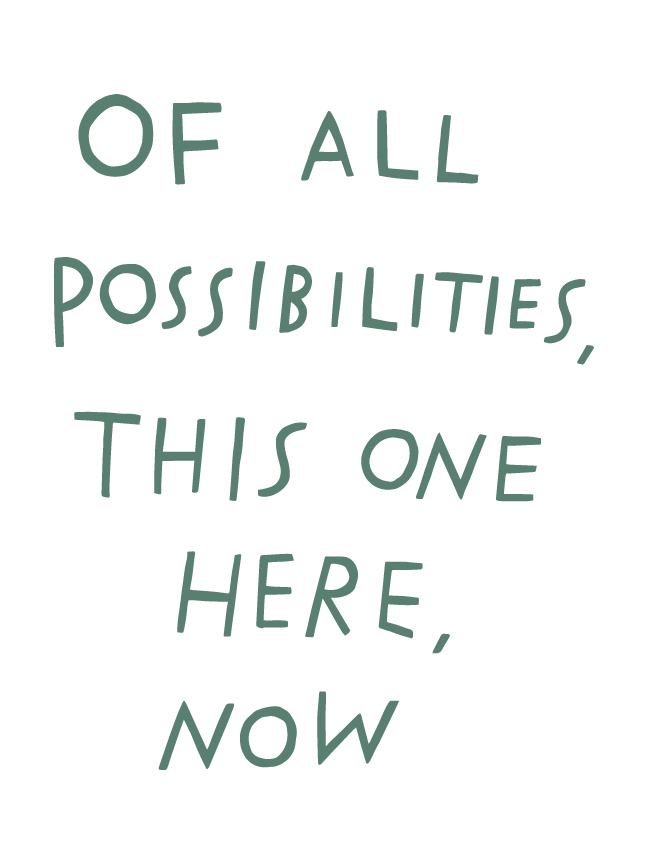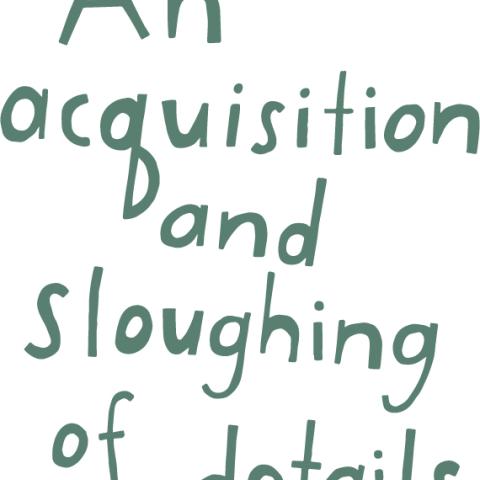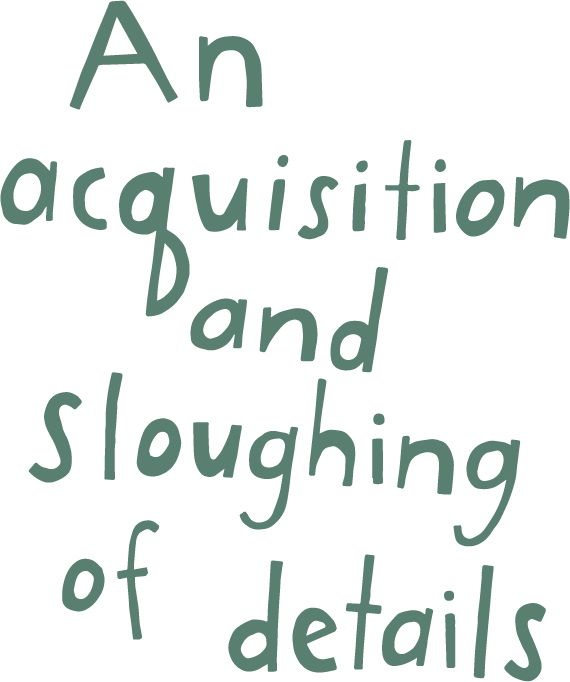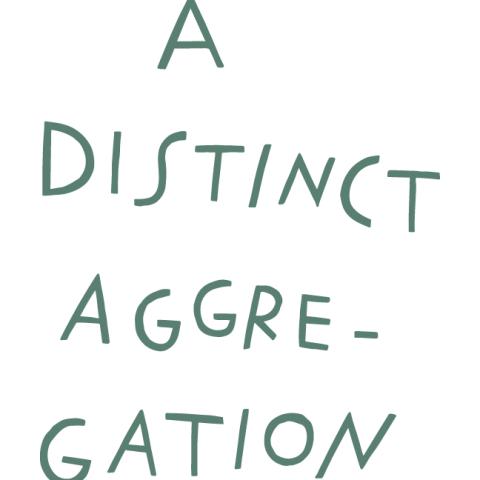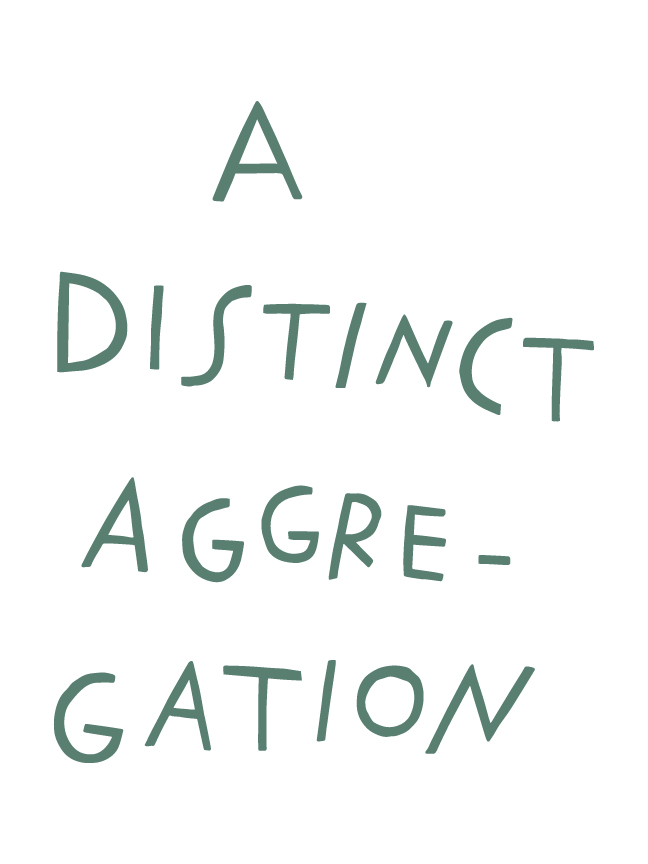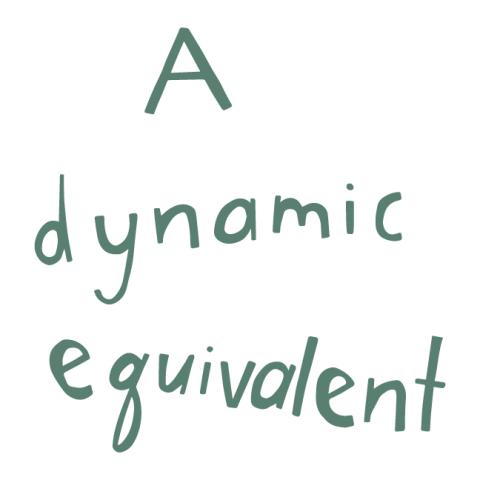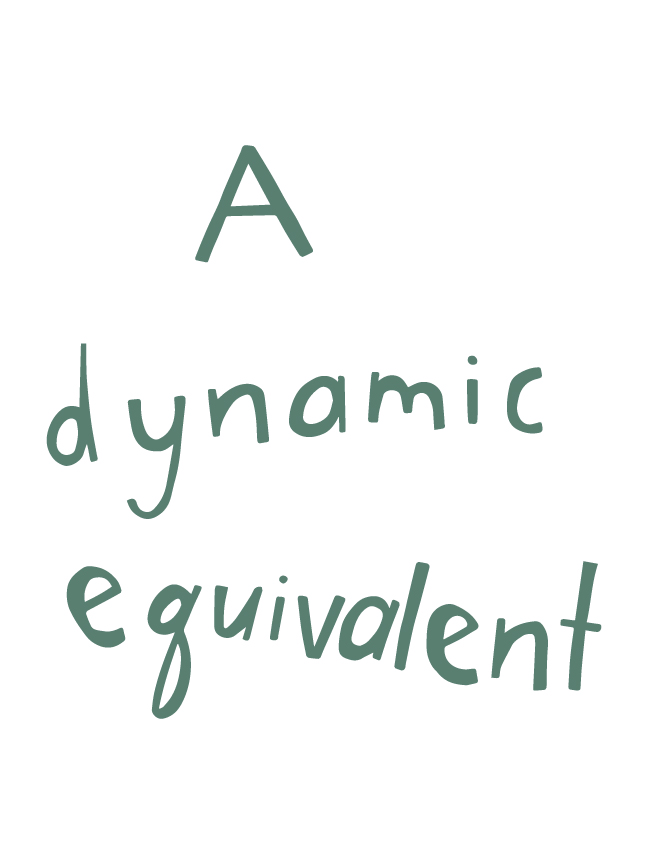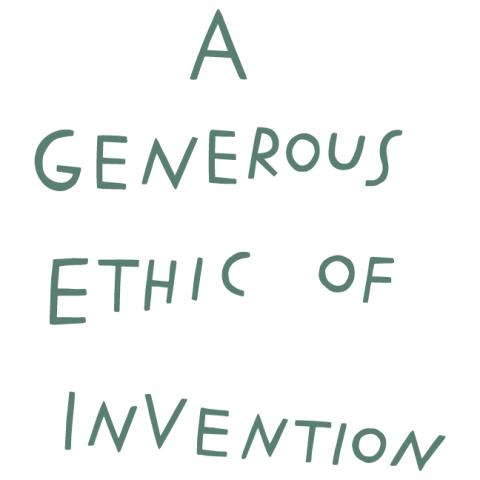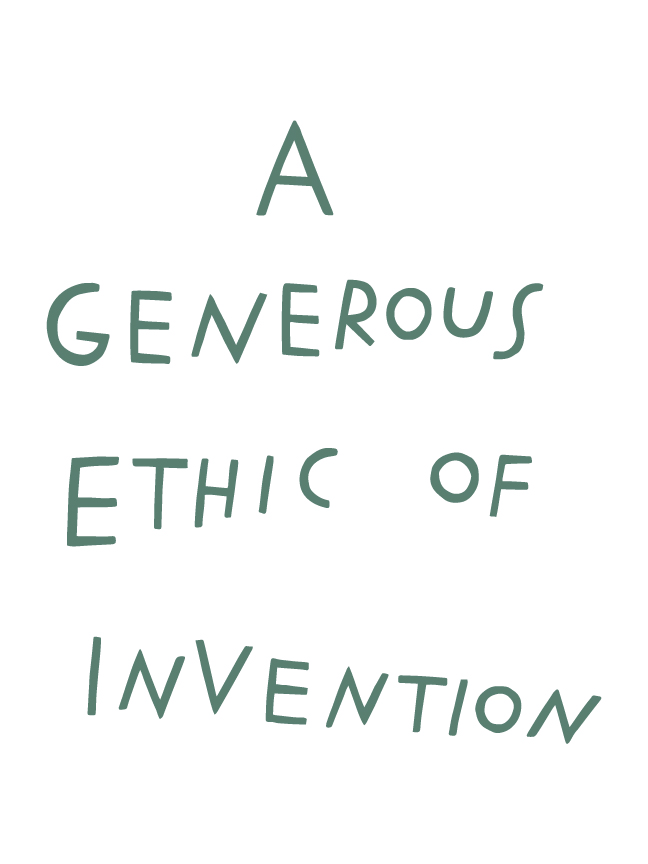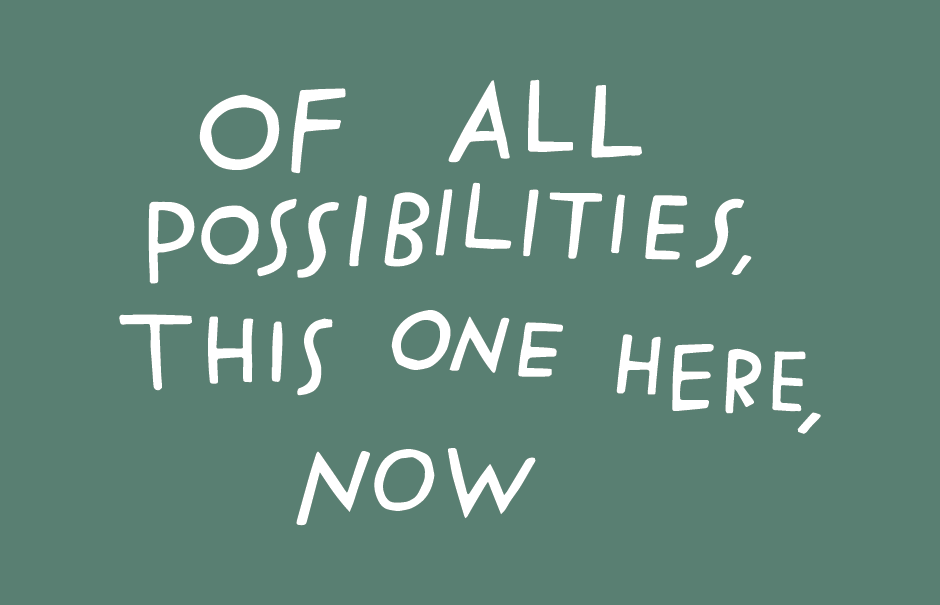
Aislinn Thomas and Finnegan Shannon, 'Of all possibilities, this one here, now.' (2019). Drawing from the collaborative series, 'A seat at the table, a slice of the pie' for 'A distinct aggregation / A dynamic equivalent / A generous ethic of invention: Six writers respond to six sculptures' (2019), commissioned by Walter Phillips Gallery, Banff Centre for Arts and Creativity.
Visual Description of Image: A text drawing that reads “Of all possibilities, this one here, now.” It's white on a muted blue-green background. The hand-lettered all caps text fills most of the image. The spacing and size of the letters vary at times. The letter shapes are graphic with confident lines, made even smoother through the digitization process, but overall the text feels wobbly and was made without the goal of perfection, symmetry, or sameness.
Extended until March 31, 2021
A distinct aggregation / A dynamic equivalent / A generous ethic of invention: Six writers respond to six sculptures
A project by Aislinn Thomas with Anna Bowen, Angela Marie Schenstead, Crystal Mowry, Laura Burke, Catherine Frazee, Nicole Kelly Westman, and Finnegan Shannon
This commissioned work is available in two formats: as a sound-work available to sign out from the Walter Phillips Gallery front desk during regular gallery hours or streamed via SoundCloud; and through a broadsheet featuring audio transcriptions of each response as well as text drawings from the collaborative series, A seat at the table, a slice of the pie, the result of a dialogue between Aislinn Thomas and Finnegan Shannon about the practice of visual description.
Within conventional museum contexts, audio description is generally understood as a means of creating access to visual art through the alternate modality of sound. Containing careful visual description with language aimed at objectivity, audio descriptions form a secondary alternative to experiencing the work in visual form. The politics of this mode of access are taken up extensively by scholar Georgina Kleege, who has argued that “[a] picture may be worth a thousand words, but the assumption seems to be that those thousand words – or even a million words – will not do justice to the picture. This holds even though ekphrasis, or poetry that describes visual art, has been around at least since Homer.”(1) In contrast to standard conceptions of audio description, Kleege invites a re-imagining of its potential; where it might be “elevated from its current status as a segregated accommodation outside the general public’s awareness and launched into the new media – a literary/interpretative form with infinite possibilities.”(2)
Similarly, Kitchener-based artist Aislinn Thomas considers museological accessibility measures such as audio description as a conceptual space for creative acts. For the commissioned work, A distinct aggregation / A dynamic equivalent / A generous ethic of invention: Six writers respond to six sculptures, Thomas invited writers living across Canada to each respond to a respective work in Banff Centre’s public art collection. The resulting poetic interventions serve as points of entry to the works beyond the visual, with responses by each author composing a downloadable audio work. In a further translation between modalities, the work also encompasses a broadsheet with transcriptions and collaborative text drawings by Thomas and Brooklyn-based artist Finnegan Shannon, offering a visual point of access.
In assembling texts which propose different possibilities for the integration of visual description within the realm of the poetic, A distinct aggregation / A dynamic equivalent / A generous ethic of invention serves as an invitation into questions of functionality in relation to audio description. In her response to Peter von Tiesenhausen’s Vessel/Enclosure (1984), Anna Bowen’s Catch describes the subtly-evolving relationship between the hand-bent willow sculpture and the groundcover it has rested upon for decades, which expands into a meditation on the daily vibrant, creaturely exchanges also taking place at the site. Angela Marie Schenstead offers poetic reflection on three ungulates – elk, moose, and caribou – whose antlers are the visual referents for the steel, white powder-coated benches that form Brian Jungen’s The ghosts on top of my head (2010-2011). While Jungen is of Dane-zaa and Swiss descent, the title of Schenstead’s response, ᒨᓴᐧ ᐋᐧᐋᐧᐢᑫᓯᐤ ᐊᑎᕁ, incorporates her family’s Cree language. A resident of Banff for over a decade, Schenstead’s response speaks to potential resonances with the title of Jungen’s work and the absence of the caribou in Banff National Park since 2009; as well as the death of a number of elk which took place near the Banff townsite in 2013. (3)
Crystal Mowry’s In Time responds to Barry Cogswell’s Dolmen Structure #5. The text draws on the synchronicity of Cogswell’s reference to dolmens or monuments made of stone, believed to have been used in prehistoric Brittany to mark the site of a grave, with what Mowry identifies as “the age of the oldest known lichen”; the small, composite organisms which can be found throughout the forests surrounding Banff and that are the same colour as the sculpture’s surface. Bridging, Laura Burke’s reflection on Hugh LeRoy’s Papillon (1979), invites a myriad of potential associations for this archway composed of stones, bound and suspended together by wire casing. In Welcome, Catherine Frazee’s response to John McEwen’s Stelco’s Cabin (1984), questions of hospitality, belonging, and their relationship to access are present in a narrative that also invites critical reflection on the various potential modes of experiencing McEwen’s work beyond the visual.
The final text, I am sorry I didn’t call – a poem for a now-vacant site, is unique in the sense that it is not a response to a work in the permanent collection. Upon receiving the invitation, Nicole Kelly Westman chose to respond to Sharon Moodie’s I don’t want a massage, I want a miracle (1989-2017); a work produced by the artist on Banff Centre’s campus, but never formally acquired. The work was removed due to attrition and vandalism in 2017.
Troubling assumptions around the assumed primacy of an ‘original’ work over ‘secondary’ forms of access; the poetic versus the didactic; and the pleasures and limitations of site-specificity from a standpoint of physical accessibility; A distinct aggregation / A dynamic equivalent / A generous ethic of invention might also be understood as aligned with a feminist approach to poetic ekphrasis: activating polyvocal exchange between people and works in expanded interrelation. (4)
It is our hope that everyone who desires to is able to experience this work. We recognize that access is a contextual and dynamic process and are here to help you navigate your access. Please contact Walter Phillips Gallery: walter_phillips_gallery@banffcentre.ca / 1.403.762.6281
- Georgina Kleege, More Than Meets the Eye: What Blindness Brings to Art. (New York: Oxford University Press, 2018), 73.
- Ibid, 108.
- C. Derworiz, “Eight elk die after falling through thin ice in Banff National Park,” Calgary Herald (2013, December 11). Retrieved from http://www.calgaryherald.com/news/alberta/eight after falling through thin Banff national park/9157297/story.html; Banff National Park, “Caribou 101: A primer,” Parks Canada Agency & Government of Canada, 2017, April 01. Retrieved from https://www.pc.gc.ca/en/pn-np/ab/banff/decouvrir-discover/faune-wildlife/caribou/initiation-primer
- For further discussion of feminist ekphrasis, see B.K. Fischer, “Shake Forth a Nest: Feminist Ekphrasis and the Example of Louise Bourgeois,” Los Angeles Review of Books, (August 9, 2014). Retrieved from: https://lareviewofbooks.org/article/feminist-ekphrasis-example-louise-bourgeois/
The work takes its title from Shannon and Thomas' text drawings which reflect on the process of generating visual descriptions. The first line, “a distinct aggregation” speaks to the fact that visual descriptions are composed of an assembly of words, ideas, and observations. The second line, “a dynamic equivalent,” refers to a term used in translation and intends to draw parallels between the act of visual description and a translative process. The third line, “a generous ethic of invention,” takes inspiration from a phrase in the article, “Shake Forth a Nest: Feminist Ekphrasis and the Example of Louise Bourgeois,” by B.K. Fischer in the Los Angeles Review of Books (August 9, 2014). Fischer’s phrase, “a strenuous ethic of invention” aligned with the project's intention of expanding access by bringing poetic and resourceful approaches to the creation of visual description. The third line in the title is a nod to Fischer. Shannon and Thomas swapped "generous" for "strenuous" out of concern that the word would support unhelpful stereotypes of access work, while also speaking to the abundance offered by each writer’s poetic response to the works in Banff Centre’s permanent public art collection.
Artist Biographies
Aislinn Thomas
Aislinn Thomas is an interdisciplinary artist whose practice includes video, performance, sculpture, installation, and text. She culls material from everyday experiences and relationships, creating work that ranges from poignant to absurd (and at times straddles both). Her recent works explore the generative potential of disability and access—her own and others’—while pushing up against the conventions of audio description.
Anna Bowen
Anna Bowen is a Guelph-based poet and writer. She has collaborated with visual artists on projects related to space, care labour, landscape, and access. Collaborations include alternative audio description with Aislinn Thomas, Three windows described by three voices [...] (2018) and a convex minutely puckered surface could be called a vertical sea (2019); durational installation Re:Mediate (2014-2016) with Christina Kingsbury; and ((Pollen)). She is currently working on a collection of poetry that examines possibilities for reciprocity and relationship with four specific trees in her local bio-region through gesture, documentation, and text. Her first collection of poetry, ReMediate, with Kingsbury, was published by PS Guelph in 2016. She is the co-producer of literary podcast, Bookishradio.ca.
Angela Marie Schenstead
Angela Marie Schenstead was born and raised in Saskatoon, and is a member of One Arrow First Nation (nêhiyawak) in Treaty Six Territory. She earned a Fine Art Diploma from Grant MacEwan University, Edmonton (2003), and a BFA in Ceramics from Alberta College of Art + Design, Calgary (2007). Her work is informed by her experience growing up in an intercultural and mixed-race family, and considers themes related to Indigeneity, identity, place, kinship, language, land, water, environmental concerns, and the effects of systemic racism and colonialism. Her visual and text-based works have been featured in various exhibitions and publications across Canada. Notable highlights include independently curating FIRE at Stride Gallery, Calgary (2012); and having her article Burnout published in the 2018 “Dirty Words” issue of Canadian Art. She is also a member of the ReMatriate Collective, who aim to empower Indigenous womxn through positive self-representation, and recently worked with three members of the collective to co-curate qaʔ yexw – water honours us: Womxn and Waterways at Bill Reid Gallery, Vancouver (2019). Based in Banff for over a decade, she has served as an arts administrator at Banff Centre for Arts and Creativity since 2007. In her spare time, she enjoys being outdoors and is happiest walking in the bush or swimming in fresh water.
Crystal Mowry
Crystal Mowry is Senior Curator at the Kitchener-Waterloo Art Gallery where she has curated solo numerous projects including group exhibitions such as The Limits (2011), Imitation of Life (2015), The Brain is wider than the Sky (2018), and I’ll be your Mirror (2018). She has Exhibition of the Year Awards from the Ontario Association of Art Galleries for two of her solo projects: Maggie Groat: Suns also Seasons (2017) and Ernest Daetwyler: Barn Raising [Reality in Reverse] (2010). In 2013 she co-curated Romancing the Anthropocene, situated in Toronto’s financial district for Nuit Blanche. Her recent publications include Still Move: Brendan Fernandes (Black Dog Publishing, 2017), on the performance and installation work of Brendan Fernandes. She regularly participates on advisory panels and industry juries, most notably for the Sobey Art Award (2015) and the RBC Canadian Painting Competition (2018).
Laura Burke
Laura Burke is a mad-identified writer/actor/performance poet based out of Halifax. In 2009, she represented Halifax on the poetry slam team at the Canadian Festival of Spoken Word in Victoria. She debuted her first play, called Voices, in San Francisco in 2011. Since then, she has written Heartwood, a confessional one woman show about her journey as a psychiatric survivor. Heartwood has toured across Canada, including at the May Works Festival and as part of Neptune Theatre’s open spaces program with Doppler Effect Theatre. An excerpt from her play Iris has been presented at the Soloicious Festival and at The Women in Theatre Festival in Halifax. Laura was a 2017 member of the Eastern Front Theatre Playwright’s Unit, and is a new member of the Bus Stop Theatre Playwright’s Unit. In 2018, Laura worked with Tangled Art + Disability’s Flourishing Project to create an early draft and workshop production of Mad Ones, a project that Arts Nova Scotia had previously supported in its early creation. Laura’s work is often about vulnerable humans who fight through their marginalization to reclaim their otherness as their birthright.
Catherine Frazee
Catherine Frazee, OC, is a Professor Emerita at Ryerson University’s School of Disability Studies, now pursuing the pleasures of an active retirement dedicated to justice, philosophy and all things fragile and wild. An alumnus of the Banff Centre’s Literary Journalism program, Frazee’s essay “Still Life: Reflections on Walking, Running and Standing” is published in the 2003 anthology, To Arrive Where You Are: Literary Journalism from the Banff Centre for the Arts.
Nicole Kelly Westman
Nicole Kelly Westman is a visual artist of Métis and Icelandic descent that recognizes with an indebted gratitude the artists that came before her and strenuously forged space, the curators that place care at the fore of their labour, the communities that foster confidence in her practice, and the institutions and organizations that implement policies prefacing relations of trust. As an artist, she enjoys practices of listening, watching, hosting, poeticizing, foraging, and sharing. Westman was previously the director of Stride Art Gallery, holds a BFA from Emily Carr University (2012), and is currently rolling through regions like a tumbleweed. Her writing has been published in C Magazine, Inuit Art Quarterly, Instudio Magazine, and Luma Quarterly.
Finnegan Shannon
Finnegan Shannon is an interdisciplinary artist. Some of their recent work includes Anti-Stairs Club Lounge, an ongoing project that gathers people together who share an aversion to stairs; Alt-Text as Poetry, a collaboration with Bojana Coklyat that explores the expressive potential of alt-text; and Do You Want Us Here or Not, a series of benches designed for exhibition spaces. They have done projects with the Museum of Contemporary Art Denver, the High Line, Tallinn Art Hall, and Nook Gallery. Their work has been supported by a 2018 Wynn Newhouse Award, a 2019 residency at Eyebeam, and a 2020 grant from Art Matters Foundation.
